Text
Final Images

Section - It was resized for 1:5 but on a screen it means nothing :(
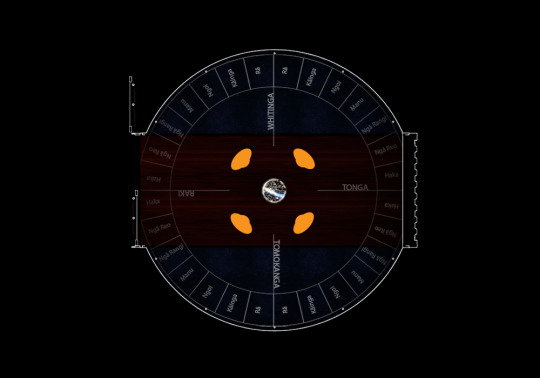
Plan - Resized for 1:10
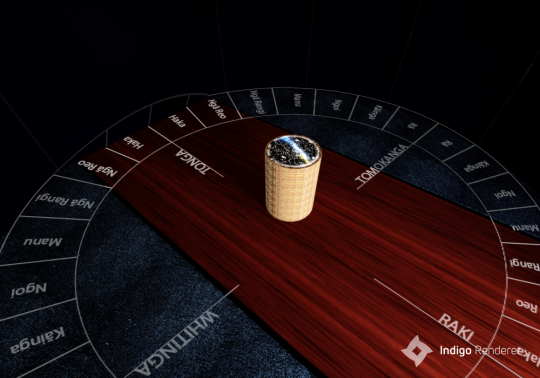
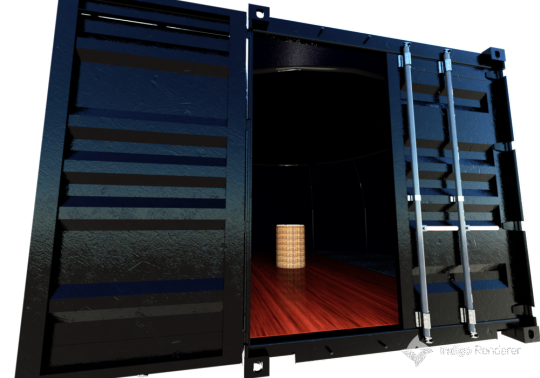

Perspectives
0 notes
Video
undefined
tumblr
A video outlining how the star locating is done on the central screen. The houses are not shown on the screen, they are projected onto the space floor.
0 notes
Video
undefined
tumblr
Perspective video test.
Will need to add details and people, but I think it will be a good representation.
0 notes
Text
Material Breakdown

Dome covering: 250µm black Polythene film covering
Waterproof, opaque, flexible and can come down easily for easy transportation.
Dome frame: Collapsible Aluminium Tent poles
The same type used for propping up tents, although a more heavy duty type. The frame will also be used to fasten the LED screens.
LED concave star dome: VSTAR flexible LED Screen - 24x triangular panels
These flexible panels are able to be as thin as one pixel wide, so is a good choice for the shape I want. I chose this over a projection as I wanted each star to be visible as a singular dot, rather than lost behind star dust and other projection light.
Orientation map projectors: EPSON EV-100 Series projectors - 4x
These projectors are small and can be mounted on narrow surfaces or on tracks, so would work well on the container frame.
Touchscreen cover: Harakeke “kete” woven material
The star map is the basket of stars Tāne took with him to Ranginui. Lighting from behind the harakeke will make it seem more like stars are being stored inside.
Star map touchscreen: EyeFactive Round Multi Touch Table AURORA
The touch screen display will have the night sky map on it for participants to find and identify the stars.
Flooring: Wooden Panels, both painted and natural
The middle floor panel will be natural, as it will be Tāne’s waka. The rounded panels will be painted black to match the dome cover.
0 notes
Link
The black PVC material exterior is a good material to use for my space. It is lightweight and flexible, and at different thicknesses can be translucent or opaque.
0 notes
Photo

Jim Campbell, Eroding Wave (2016), From Bryce Wolkowitz Gallery
LED globes suspended on a grate could be a way to make my star dome
5 notes
·
View notes
Photo

Māori months, and their counterparts. New year stars in Pipiri.
0 notes
Text
Notes on Star Risings and Settings
I Spent some time on Stellarium tracking where and when some important stars and constellations rise and set. These clues can be used to help participants to find these stars on the touch screen.
Puanga - Rigel
- Rises at dawn in Rā between Whitinga and Tonga (June 1)
- Sets at dawn in Ra between Tomokanga and Tonga (June 30)
Takarua - Sirius
- Rises at sawn in Kāinga between Whitinga and Tonga (June 8)
- Sets at dawn in Kāinga between Tomokanga and Tonga (February 2)
Tautoru (Orion’s Belt)
- Rises at dawn in Rā between Raki and Whitinga (June 9)
- Sets at dawn in Rā between Raki and Tomokanga (January 9)
Rua Wāhia (Acturus)
- Rises at dawn in Ngoi between Raki and Whitinga (December 17)
- Sets at dawn in Ngoi between Raki and Tomokanga (April 16)
Whānui (Vega)
- Rises at sunset in Ngā Rangi between Raki and Whitinga (August 20)
- Sets at sunset in Ngā Rangi between Raki and Tomokanga (Nov 11)
Atuatahi (Canopus)
- Canopus does not rise or set
- Directly at Tonga at sunset (September 25)
- Directly at Tonga at dawn (April 1)
Rehua (Antares)
- Rises at sunset in Ngoi between Whitinga and Tonga (May 23)
- Sets at dawn Ngoi betqween Tookangfa and Tonga (Jun 9)
Matariki (Pleaides)
- Rises at dawn in Ngoi between Raki and Whitinga (Jun 5)
- Sets at sunset in Ngoi between Raki and Tomokanga (May 3)
Unfortunately the risings and settings are at different dates each year, so it would be better to generalize under months rather than actual dates.
0 notes
Text
My space will be teaching people of some of the stars in our night sky by way of placing them in the position of Tāne, who adorned Ranginui’s cloak/breast with the Whānau Mārama (the family of light).
Through audio and visual clues, participants will work together to identify and place certain important stars and constellations into the sky.
The space will act as a giant compass, which will have markings on the floor similar to one developed by Polynesian navigator Nainoa Thompson, which was used for navigation.
As my space will be more focused on the land and kaitiakitanga, my star map will point out the spaces and times of the year where stars rise and set, which gave Māori cues for the seasons.
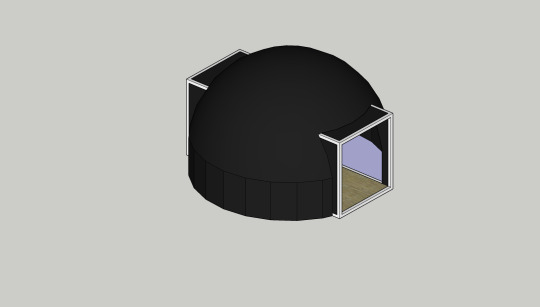
HOPEFULLY my space will only use the frame of the container, and I can place an inflatable or collapsible dome for my star map. The entrance and exit will be oriented North to South (Raki and Tonga), as there are no stars that rise or set close to these points.
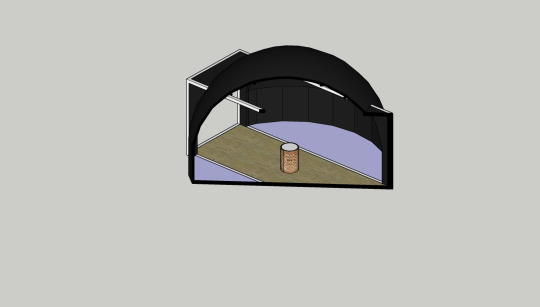
Inside, the walkway will be a wooden walkway from entrance to exit, to represent the bottom of the waka Tāne used to sail up to the heavens. In the centre will be an interactive screen, wrapped in flax weaving - like the kete Tāne had gathered the stars in.
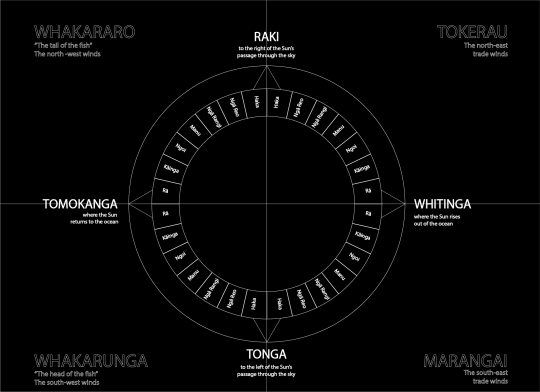
It will be dark, and a projection segmenting the houses and directions can be seen on the floor and walls under the dome.
Kōrero will guide the participants use the sky map on the central screen, which will function much like that found here: https://stellarium-web.org/. The time of year and day can be altered to find the right star at it’s rising or setting house.
When the correct star has been identified, the participants can press it, which will then be “placed” on the dome above them (by projection or installed LED lighting).
Each prompt will come with a story, such as the indication of a new season when this star is seen, or a small story about a constellation.

Hopefully by the end the participants will have gained knowledge in way-finding and orientation using the Māori star navigation system.
-----
A fun note about the story of Tāne putting up the stars, when he saw what a great job he did, he did a haka. During, he accidentally knocked over the basket of stars, and they scattered across the sky. I would like to add this idea into the interactivity, maybe by letting the participants plant their own stars.
0 notes
Photo
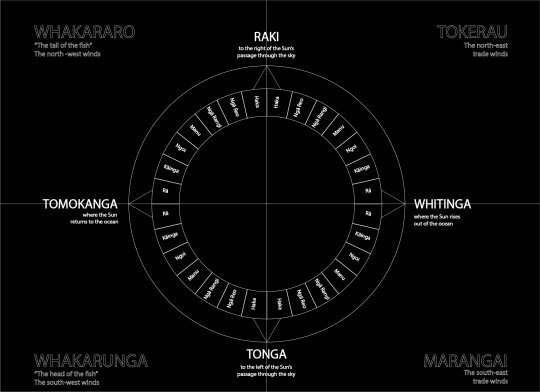
A chart I made outlining the directions, winds and houses of the Maori star chart.
The small house names are as follows:
Rā – the Sun
Kāinga – where the Sun lives
Ngoi – a land bird (the brown noddy) used by navigators to find land
Manu – the waka as a bird flying across the ocean
Ngā Rangi – the heavens are where we get our clues
Ngā Reo – the navigator listens to the voices of the stars that guide him
Haka – the void where there are no clues, where the true challenge begins.
https://www.sciencelearn.org.nz/resources/622-the-star-compass-kapehu-whetu
0 notes
Text
Links to Star Maps and Other Resources
https://www.sciencelearn.org.nz/resources/622-the-star-compass-kapehu-whetu
https://www.rnz.co.nz/national/programmes/nights/audio/201800524/maori-astronomy-te-whanau-marama
https://www.mcguinnessinstitute.org/foresightnz/matariki-and-maori-astronomy-with-dr-rangi-matamua/
http://warrenpohatu.blogspot.com/2013/04/lining-up-stars-at-night.html
0 notes
Text
Māori Food Calendars
These are four charts which illustrate the complex system Māori used to plant and gather food.
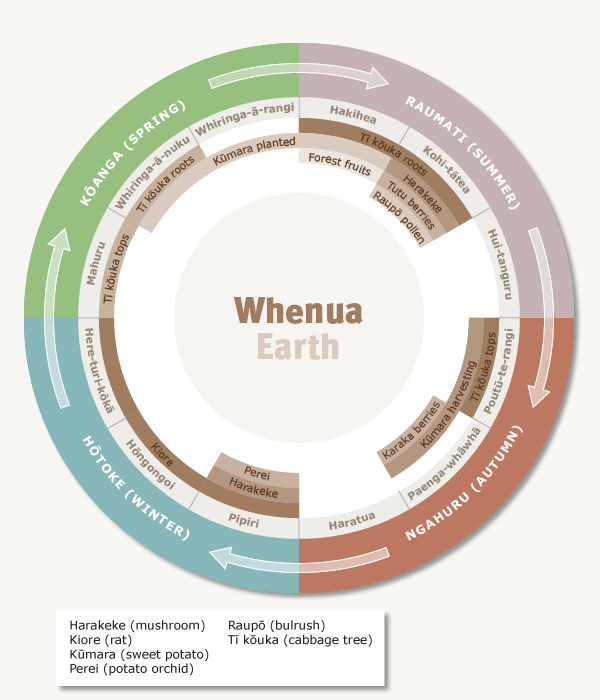
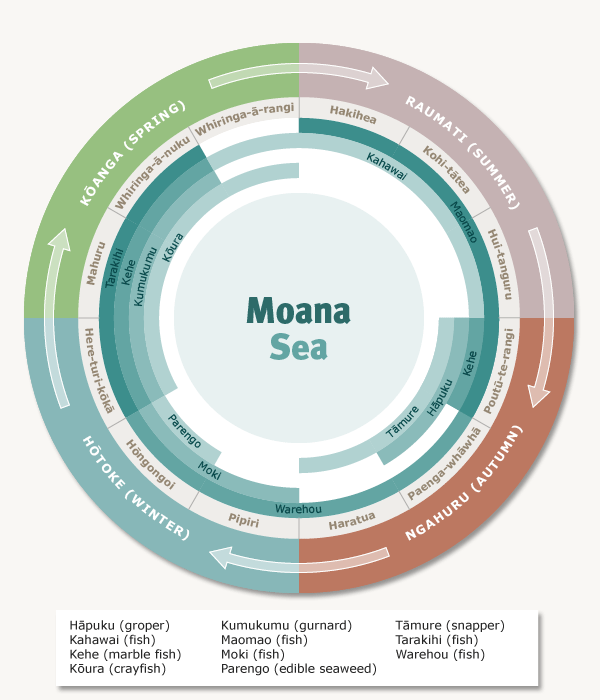

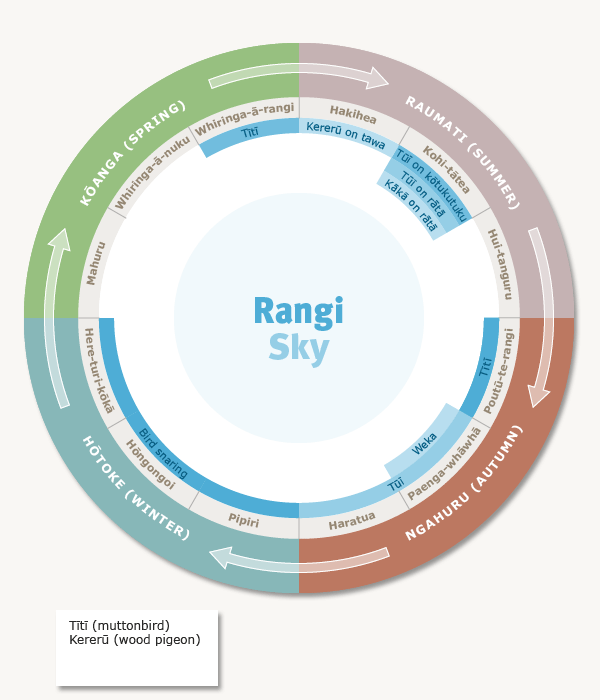
These systems are dictated by the Maramataka and star movements. I will be focusing on the stars in the sky in my space, and can use these charts for information to the participants on which food is abundant at certain times their stars rise in the evening.
1 note
·
View note
Text
A Further Idea?
I’m thinking about taking a slight turn on my idea about Matariki.
Our participants will be taking on the role of Tāne, who takes Te Whānau Mārama (the family of light) in basket up to adorn Ranginui’s cloak, and to flood the world with light.
In the centre of the room will be an interactive screen of the night sky. Participants are able to change the seasons and time to move the sky. As the main way to share knowledge is through korero, so audio cues will direct participants to find each star.

I am going by the Tūhoe version of Matariki, as there are more stars and better ways to visualize each star’s meaning. Each star will guide the participants to find them within the cluster. Once they have been found, the space will react with sounds and lights, and the corresponding star will be visible on the ceiling.
Matariki - Navigation. Beginnings. Mother of the family. Time to be together. Once activated, dim stars will fill the walls and Matariki will shine on the ceiling.
Waitā – Ocean. Fish. Full moon for fishing. Once activated, the participants will be surrounded by “water” (floor projection) and fish. Waitā will shine on the ceiling.
Tupuānuku – Soil. Ground. Paranoke. grass. farming at full moon. Once activated, the “boat” will come to shore and the ocean will fade away. Tupuānuku will shine on the ceiling.
Ururangi – Winds. Once activated, the sound of wind will activate and fans will blow air in the container. clouds will be visible on the walls. Ururangi will shine on the ceiling.
Waipunarangi – Rain. Clouds. Mist. Growth and nourishment for plants. Once activated, mist will be released at the participants feet, and the sound of distant thunder. Then the sound of rain will play. Waipunarangi will shine on the ceiling.
Tupuārangi – Trees. Plants. Birds. Fruits. Manu teach us who our allies are. Once activated, plants and trees will grow rapidly on the walls. The rain sound and mist will stop, and Bird calls will be heard. Tupuārangi will shine on the ceiling.
Waitī – Awa. Korokoro migration. Kokopu. Taniwha. Once activated, a river will flow on the ground and snake its way past the length of the container. Eels will be swimming through. The sound of flowing water will be heard. Waitī will shine on the ceiling.
Pōhutukawa – Paying respects to those who have passed. Te Awa Wairua. Kuaka (Bar Tailed Godwit), Once activated, spirits will gather on the walls, and the call of the kuaka can be heard. For a short time the participants will be encouraged to remember those they may have lost. Pōhutukawa will shine on the ceiling.
Hiwaiterangi – Dreams. Wishes. Once activated the participants will be given an opportunity to make a wish. Hiwaiterangi will shine on the ceiling.
2 notes
·
View notes
Link
These mini podcasts are a guide to find and understand each of the nine stars of Matariki (Tūhoe legend).
I would like to use this style to guide participants to finding the stars of Matariki on the interactive screen.
0 notes
Photo

Listening to the videos of the creation of the starry sky, I formed an idea where participants can take on the role of Tāne adorning Ranginui with the family of light (Whānau Mārama). Audio and visual cues can guide the participants to find the star/constellation/planet on a touchscreen in the middle of the space. Once the right star has been found, it is then “placed” onto the walls of the space.
Optional?: A story about the star or constellation is unlocked also.
0 notes